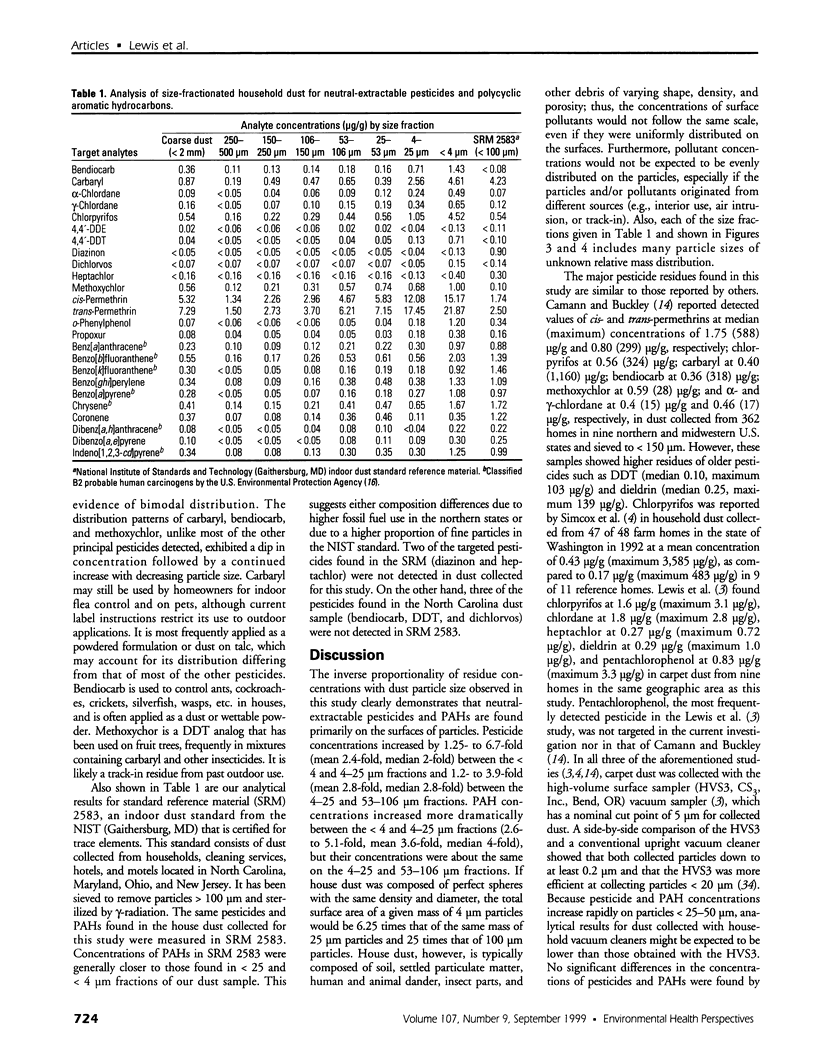Abstract
House dust is a repository for environmental pollutants that may accumulate indoors from both internal and external sources over long periods of time. Dust and tracked-in soil accumulate most efficiently in carpets, and the pollutants associated with dust and soil may present an exposure risk to infants and toddlers, who spend significant portions of their time in contact with or in close proximity to the floor and who engage in frequent mouthing activities. The availability of carpet dust for exposure by transfer to the skin or by suspension into the air depends on particle size. In this study, a large sample of residential house dust was obtained from a commercial cleaning service whose clients were homeowners residing in the Raleigh-Durham-Chapel Hill (Research Triangle) area of North Carolina. The composite dust was separated into seven size fractions ranging from < 4 to 500 microm in diameter, and each fraction was analyzed for 28 pesticides and 10 polycyclic aromatic hydrocarbons (PAHs). Over 20% of the fractionated dust sample consisted of particles < 25 microm in diameter. Fourteen pesticides and all 10 of the target PAHs were detected in one or more of the seven size-fractionated samples. Sample concentrations reported range from 0.02 to 22 microg/g; the synthetic pyrethroids cis- and trans-permethrin were the most abundant pesticide residue. The concentrations of nearly all of the target analytes increased gradually with decreasing particle size for the larger particles, then increased dramatically for the two smallest particle sizes (4-25 microm and < 4 microm).
Full text
PDF





Images in this article
Selected References
These references are in PubMed. This may not be the complete list of references from this article.
- Barltrop D., Meek F. Effect of particle size on lead absorption from the gut. Arch Environ Health. 1979 Jul-Aug;34(4):280–285. doi: 10.1080/00039896.1979.10667414. [DOI] [PubMed] [Google Scholar]
- Chuang J. C., Callahan P. J., Lyu C. W., Wilson N. K. Polycyclic aromatic hydrocarbon exposures of children in low-income families. J Expo Anal Environ Epidemiol. 1999 Mar-Apr;9(2):85–98. doi: 10.1038/sj.jea.7500003. [DOI] [PubMed] [Google Scholar]
- Clayton C. A., Perritt R. L., Pellizzari E. D., Thomas K. W., Whitmore R. W., Wallace L. A., Ozkaynak H., Spengler J. D. Particle Total Exposure Assessment Methodology (PTEAM) study: distributions of aerosol and elemental concentrations in personal, indoor, and outdoor air samples in a southern California community. J Expo Anal Environ Epidemiol. 1993 Apr-Jun;3(2):227–250. [PubMed] [Google Scholar]
- Colt J. S. Comparison of pesticides and other compounds in carpet dust samples collected from used vacuum cleaner bags and from a high-volume surface sampler. Environ Health Perspect. 1998 Nov;106(11):721–724. doi: 10.1289/ehp.98106721. [DOI] [PMC free article] [PubMed] [Google Scholar]
- Davies J. E., Edmundson W. F., Raffonelli A. The role of house dust in human DDT pollution. Am J Public Health. 1975 Jan;65(1):53–57. doi: 10.2105/ajph.65.1.53. [DOI] [PMC free article] [PubMed] [Google Scholar]
- Driver J. H., Konz J. J., Whitmyre G. K. Soil adherence to human skin. Bull Environ Contam Toxicol. 1989 Dec;43(6):814–820. doi: 10.1007/BF01702049. [DOI] [PubMed] [Google Scholar]
- Duggan M. J., Inskip M. J., Rundle S. A., Moorcroft J. S. Lead in playground dust and on the hands of schoolchildren. Sci Total Environ. 1985 Jul;44(1):65–79. doi: 10.1016/0048-9697(85)90051-8. [DOI] [PubMed] [Google Scholar]
- Freeman G. B., Johnson J. D., Killinger J. M., Liao S. C., Feder P. I., Davis A. O., Ruby M. V., Chaney R. L., Lovre S. C., Bergstrom P. D. Relative bioavailability of lead from mining waste soil in rats. Fundam Appl Toxicol. 1992 Oct;19(3):388–398. doi: 10.1016/0272-0590(92)90178-k. [DOI] [PubMed] [Google Scholar]
- Lefcoe N. M., Inculet I. I. Particulates in domestic premises. II. Ambient levels and indoor-outdoor relationships. Arch Environ Health. 1975 Dec;30(12):565–570. doi: 10.1080/00039896.1975.10666780. [DOI] [PubMed] [Google Scholar]
- Lewis R. G., Fortmann R. C., Camann D. E. Evaluation of methods for monitoring the potential exposure of small children to pesticides in the residential environment. Arch Environ Contam Toxicol. 1994 Jan;26(1):37–46. doi: 10.1007/BF00212792. [DOI] [PubMed] [Google Scholar]
- Lioy P. J., Wainman T., Zhang J., Goldsmith S. Typical household vacuum cleaners: the collection efficiency and emissions characteristics for fine particles. J Air Waste Manag Assoc. 1999 Feb;49(2):200–206. doi: 10.1080/10473289.1999.10463789. [DOI] [PubMed] [Google Scholar]
- Que Hee S. S., Peace B., Clark C. S., Boyle J. R., Bornschein R. L., Hammond P. B. Evolution of efficient methods to sample lead sources, such as house dust and hand dust, in the homes of children. Environ Res. 1985 Oct;38(1):77–95. doi: 10.1016/0013-9351(85)90074-x. [DOI] [PubMed] [Google Scholar]
- Simcox N. J., Fenske R. A., Wolz S. A., Lee I. C., Kalman D. A. Pesticides in household dust and soil: exposure pathways for children of agricultural families. Environ Health Perspect. 1995 Dec;103(12):1126–1134. doi: 10.1289/ehp.951031126. [DOI] [PMC free article] [PubMed] [Google Scholar]
- Starr H. G., Jr, Aldrich F. D., MacDougall W. D., 3rd, Mounce L. M. Contribution of household dust to the human exposure to pesticides. Pestic Monit J. 1974 Dec;8(3):209–212. [PubMed] [Google Scholar]






